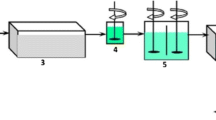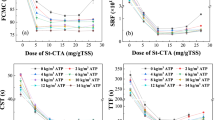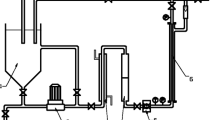Abstract
In this study, cassava starch wastewater was subjected to coagulation/flocculation (C/F) combined with microfiltration (MF) to improve the final quality of treated water. In the C/F tests of the effluent, the best concentration of the natural coagulant (Tanfloc POP) was determined from a statistical analysis of color removal and turbidity data. The supernatant produced in the C/F step was subjected to MF while varying the transmembrane pressure to evaluate the permeate fluxes, fouling mechanism, and permeate quality. The mathematical model that best represented the filtration process was the fouling mechanism of partial membrane pore blockage. The best experimental conditions for coagulant dosage, settling time, and MF pressure in the combined C/F-MF process were 320 mg L−1, 15 min, and 1.4 bar, respectively. The highest overall removal efficiency rates achieved were 99% color, 91% cyanide, 75% total organic carbon, and 100% turbidity, demonstrating the promising potential of the combined C/F-MF process in the treatment of cassava starch wastewater.





Similar content being viewed by others
References
Abbasi, M., & Taheri, A. (2013). Effect of coagulant agents on oily wastewater treatment performance using mullite ceramic MF membranes: experimental and modeling studies. Chinese Journal of Chemical Engineering, 21, 1251–1259.
Abidin, Z. Z., Shamsudin, N. S. M., Madehi, N., & Sobri, S. (2013). Optimisation of a method to extract the active coagulant agent from Jatropha curcas seeds for use in turbidity removal. Industrial Crops and Products, 41, 319–323.
APHA, AWWA and WEF. (2005). Standard methods for examination of water and wastewater (21th ed.). Washington: American Public Health Association.
APHA, AWWA and WEF. (2012). Standard methods for examination of water and wastewater (22th ed.). Washington: American Public Health Association.
Beltrán-Heredia, J., Sánchez-Martín, J., & Jiménez-Giles, M. (2011). Tannin-based coagulants in the depuration of textile wastewater effluents: elimination of anthraquinonic dyes. Water Air Soil Pollution, 222, 53–64.
Cardoso, A. P., Mirione, E., Ernesto, M., Massaza, F., Cliff, J., Haque, M. R., & Bradbury, J. H. (2005). Processing of cassava roots to remotecyanogens. Journal Food of Composition and Analysis, 18, 451–460.
Cheryan, M. (1998). Ultrafiltration and microfiltration handbook (2th ed.). Boca Raton: CRC. Press.
Chiemchaisri, C., Chiemchaisri, W. T., Kornboonraksa, C., Dumrongsukit, S., Threedeach, H. H., & Ngo, S. V. (2005). Particle and microorganism removal in floating plastic media coupled with microfiltration membrane for surface water treatment. Water Science and Technology, 51, 93–100.
Coral, L. A., Bergamasco, R., & Bassetti, F. J. (2009). Estudo da viabilidade de utilização do polímero natural (TANFLOC) em substituição ao sulfato de alumínio no tratamento de águas para consumo. Key Elements for a Sustainable World: Energy, Water and Climate Change, 2, 1–9.
Eisler, R., & Wiemeyer, S. N. (2004). Cyanide hazards to plants and animals from gold mining and related water issues. Reviews Environmental Contamination Toxicology, 183, 21–54.
Field, R. W., Wu, D., Howell, J. A., & Gupta, B. B. (1995). Critical flux concept for microfiltration fouling. Journal of Membrane Science, 100, 250–272.
Gallego-Molina, A., Mendoza-Roca, J. A., AGUADO, D., & Galiana-Aleixandre, M. V. (2013). Reducing pollution from the deliming–bating operation in a tannery. Wastewater reuse by microfiltration membranes. Chemical Engineering Research and Design, 91, 369–376.
Girard, B., & Fukumoto, L. R. (2000). Membrane processing of fruit juices and beverages: a review. Critical Reviews in Food Science and Nutrition, 40, 91–157.
Habert, A. C., Borges, C. P., & Nobrega, R. (2006). Processos de separação com membranas. Rio de Janeiro E- papers. Instituto Alberto Luiz Coimbra de Pós Graduação e Pesquisa de Engenharia (COPPE) – Universidade Federal do Rio de Janeiro - UFRJ.
Harrelkas, F., Azizi, A., Yaacoubi, A., Benhammou, A., & Pons, M. N. (2009). Treatment of textile dye effluents using coagulation–flocculation coupled with membrane processes or adsorption on powdered activated carbon. Desalination, 235, 330–339.
Inoue, K. R. A., Souza, C. F., Matos, A. T., Santos, N. T., & Alves, E. E. N. (2010). Características do solo submetido a tratamentos com biofertilizantes obtidos na digestão da manipueira. Revista Tecnologia & Ciência Agropecuária, 4, 47–52.
Kaewkannetra, P. T., Imai, F. J., Garcia-Garcia, T., & Chiu, Y. (2009). Cyanide removal from cassava mill wastewater using Azotobactor vinelandii TISTR 1094 with mixed microorganisms in activated sludge treatment system. Journal of Hazardous Materials, 172, 224–228.
Kim, S.-H., Moon, S.-Y., Yoon, C.-H., Yim, S.-K., & Cho, J.-W. (2005). Role of coagulation in membrane filtration of wastewater for reuse. Desalination, 173, 301–307.
Kimura, K., Tanaka, K., & Watanabe, Y. (2014). Microfiltration of different surface waters with/without coagulation: clear correlations between membrane fouling and hydrophilic biopolymers. Water Research, 49, 434–443.
Mackereth, F. Y. H., Heron, J. G., & Talling, J. (1978). Water analysis: some revised methods for limnologists. Fresh Biological Association, 36.
Madariaga, C. B., & Aguirre, J. (2011). Combination treatment of corn starch wastewater by sedimentation, microfiltration and reverse osmosis. Desalination, 279, 285–290.
Moravia, W. G., Lange, L. C., & Amaral, M. C. S. (2011). Avaliação da microfitração para remoção do lodo gerado no processo oxidativo avançado empregando o reagente de Fenton no tratamento de lixiviado de aterro sanitário. Engenharia Sanitária Ambiental, 16, 379–386.
Oladoja, N. A. (2015). Headway on natural polymeric coagulants in water and wastewater treatment operations. Journal of Water Process Engineering, 6, 174–192.
Papong, S., Malakul, P., Trungkavashirakun, R., Wenunun, P., Chom-In, T., Nithitanakul, M., & Sarobol, E. (2014). Comparative assessment of the environmental profile of PLA and PET drinking water bottles from a life cycle perspective. Journal of Clean Production, 65, 539–330.
Prasad, R. K. (2009). Color removal from distillery spent wash through coagulation using Moringa oleifera seeds: use of optimum response surface methodology. Journal of Hazardous Materials, 165(1–3), 804–811.
Ramachandra, R. H. G. (2002). Mechanisms of flux decline during ultrafiltration of dairy products and influence of pH on flux rates of whey and buttermilk. Desalination, 144, 319–324.
Renault, F., Sancey, B., Badot, P. M., & Crini, G. (2009). Chitosan for coagulation/flocculation processes—an eco-friendly approach. European Polymer Journal, 45, 1337–1348.
Saif, M. M. S., Kumar, N. S., & Prasad, M. N. V. (2012). Binding of cadmium to Strychnos potatorum seed proteins in aqueous solution: adsorption kinetics and relevance to water purification. Colloids and Surfaces B: Biointerfaces, 94, 73–79.
Sanghi, R., Bhattacharya, B., & Singh, V. (2006). Use of Cassia javahikai seed gum and gum-g-polyacrylamide as coagulant aid for the decolourization of textile dye solutions. Bioresource Technology, 97, 1259–1264.
Sastre, A. M., Anil, K. P., & Syed, S. H. R. (2008). Membrane applications in chemical and pharmaceutical industries and in conservation of natural resources: introduction. London: CRC Press.
Savitha, S., Subramaniam, S., Krishnasamy, S., & Feng, H. L. (2009). A prototype of proposed treatment plant for sago factory effluent. Journal of Cleaner Production, 17, 1363–1372.
Shang, X., Kim, C., Huang, J., & Dempsey, B. A. (2015). Coagulation strategies to decrease fouling and increase critical flux and contaminant removal in microfiltration of laundry wastewater. Separation and Purification Technology, 147, 44–50.
Silva, T. O. D., Rocha, A. W. S., & Teran, F. J. C. (2011). Microfiltração como processo de tratamento avançado para efluente industrial de abatedouro de bovinos. Engenharia Ambiental, 8, 23–30.
Skoronski, E., Niero, B., Fernandes, M., Alves, M. V., & Trevisan, V. (2014). Estudo da aplicação de tanino no tratamento de água para abastecimento captada no rio Tubarão na cidade de Tubarão/SC. Ambiente & Água - Revista Ambiental Água, 9, 1–9.
Souza, S. O., Silva, A. P. B., Silva, R. M., Oliveira, L. C., Goveia, D., & Botero, W. G. (2015). Resíduos de casas de farinha do agreste alagoano: perspectivas de utilização. Brazilian Journal of Biosystems Engineering, 9(1), 65–73.
Souza, M. T. F., Almeida, C. A., Ambrosio, E., Santos, L. B., Freitas, T. K. F. S., Manholer, D. D., Carvalho, G. M., & Garcia, J. C. (2016). Extraction and use of Cereus peruvianus cactus mucilage in the treatment of textile effluents. Journal of the Taiwan Institute of Chemical Engineers, 67, 174–183.
Suhartini, S., Hidayat, N., & Rosaliana, E. (2013). Influence of powdered Moringa oleifera seeds and natural filter media on the characteristics of tapioca starch wastewater. International Journal of Recycling of Organic Waste in Agriculture, 40093, 2–12.
Suprapti, L. (2005). Tepung Tapioka Pembuat and an Pemanfaatannya (Tapioca starch: processing and utilisation). Penerbit Kanisius, Yogyakarta, 1th ed. ISBN 979-21-0854-8.
Tawfik, A., Elsayed, H., Dessouki, H. (2013). Hydrogen and methane production from starch wastewater in a mesophillic anaerobic baffled reactor. Seventeenth International Water Technology Conference (IWTC17), Istanbul. http://iwtc.info/wp-content/uploads/2013/11/75.pdf. Accessed 03 May 2017.
Ubalua, A. O. (2007). Cassava wastes: treatment options and value addition alternatives. African Journal Biotechnology, 6, 2065–2073.
Vidal, C. M. S., & Campos, J. R. (2009). Coagulação associada à microfiltração para o tratamento avançado de esgoto sanitário. Ambiência, 5, 101–114.
Acknowledgments
The authors gratefully acknowledge the Brazilian research funding agency CAPES (Federal Agency for the Support and Improvement of Higher Education) for its financial support of this work.
Author information
Authors and Affiliations
Corresponding author
Rights and permissions
About this article
Cite this article
dos Santos, J.D., Veit, M.T., Palácio, S.M. et al. Evaluation of the Combined Process of Coagulation/Flocculation and Microfiltration of Cassava Starch Wastewater: Removal Efficiency and Membrane Fouling. Water Air Soil Pollut 228, 238 (2017). https://doi.org/10.1007/s11270-017-3416-3
Received:
Accepted:
Published:
DOI: https://doi.org/10.1007/s11270-017-3416-3




